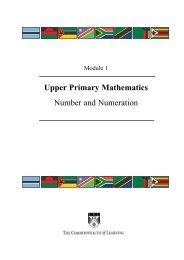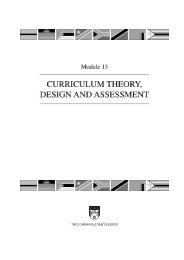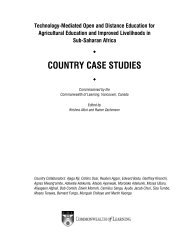Upper Primary Mathematics Fractions - Commonwealth of Learning
Upper Primary Mathematics Fractions - Commonwealth of Learning
Upper Primary Mathematics Fractions - Commonwealth of Learning
Create successful ePaper yourself
Turn your PDF publications into a flip-book with our unique Google optimized e-Paper software.
Answers to Practice Activity 2<br />
4<br />
2. a) b)<br />
5<br />
3.<br />
Answer to Reflection (Just before Practice Activity 5)<br />
Normally we do not provide answers to reflections, since their purpose is for<br />
you to think freely. This time we do, to help you avoid the teaching trap that<br />
this reflection suggests. Do not use a physical analogy to justify the upper<br />
and lower parts <strong>of</strong> a fraction—it confuses many pupils, some <strong>of</strong> them<br />
permanently. A baby monkey is not a fraction <strong>of</strong> its mother and you will<br />
shatter your pupils’ developing concept <strong>of</strong> fractions if you suggest that it is.<br />
Since you used “carry” when you taught addition, you should not suggest that<br />
the denominator “carries” the numerator. If you do, some pupils will forever<br />
confuse division and addition.<br />
Answers to Practice Activity 5<br />
1.<br />
2.<br />
2<br />
6<br />
= 1<br />
3<br />
b<br />
d<br />
a) set model b) number line<br />
5<br />
6<br />
=<br />
3<br />
= = a whole<br />
2<br />
2<br />
2<br />
Answers to Self Assessment<br />
10<br />
1.<br />
10<br />
is neither a proper or improper fraction.<br />
2. Rename the mixed number as a whole number and a fraction. Then find<br />
an equivalent fraction <strong>of</strong> the whole number whose denominator is the<br />
denominator <strong>of</strong> the fraction part. This is what brings in the multiplication<br />
<strong>of</strong> a whole number by a denominator. Now the two numbers have the<br />
same denominators. So we add the numerators.<br />
For instance, 4<br />
2<br />
= 4 +<br />
2<br />
= (4 ×<br />
3<br />
) +<br />
2<br />
3 3 3 3<br />
=<br />
12<br />
+<br />
2<br />
+<br />
12 + 2<br />
=<br />
14<br />
3 3 3 3<br />
Module 2: Unit 1 14<br />
Common <strong>Fractions</strong><br />
0<br />
5<br />
6<br />
1









